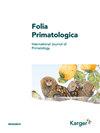社会网络和容忍度差异与geoffroyi的分组模式有关
IF 0.8
4区 生物学
Q2 ZOOLOGY
引用次数: 0
摘要
每个物种都表现出一定程度的社会容忍度。然而,在一个物种内,个体在接受共同感兴趣的资源周围的同种存在的能力上表现出差异。社会结构研究允许研究社会关系如何在一个群体中产生,它们如何随着时间的推移而生存或结束,以及它们如何受到群体组成,交配系统和栖息地质量变化等各种因素的影响。此外,它可以帮助阐明个人对其他群体成员的宽容,以及这种宽容的变化如何导致社会稳定的变化。社会网络分析(SNA)是一种评估社会动态和互动的工具。我们的目标是通过研究不同规模和组成的社会群体形成的社会网络来评估和比较圈养蜘蛛猴(Ateles geoffroyi)的社会容忍度。我们比较了不同性别比例、群体规模和年龄比例的圈养群体的社会网络。结果表明,具有相似大小和组成的网络之间存在一定的关系。较小的群体表现出更大的社会距离,而较大的群体表现出更短的个体间距离和更多的联系。与两性组成的组相比,单性组的激动作用很少发生。最后,男性较多的群体表现出更大的社会距离和更大的激动情绪。总的来说,最大的群体(五人以上)和相似的性别比例(或单性)联系得更好。与小群体相比,大群体表现出更高的接近水平和对同种生物的耐受性。本文章由计算机程序翻译,如有差异,请以英文原文为准。
Social networks and tolerance differences associated to grouping patterns in Ateles geoffroyi
Each species displays a certain level of social tolerance. However, within a species, individuals show differences in their ability to accept the presence of conspecifics around resources of mutual interest. Social structure research allows studying how social relationships arise within a group, how they survive or end through time, and how they are influenced by various factors such group composition, mating system, and habitat quality variations. Furthermore, it can help elucidate the tolerance of individuals to other group members and how changes in it may lead to changes in social stability. Social Network Analysis (SNA) is a tool that allows the assessment of social dynamics and interactions. Our goal was to evaluate and compare social tolerance in captive spider monkeys (Ateles geoffroyi) by examining social networks formed in social groups that varied in size and composition. We compared social networks of captive groups varying in sex ratio, group size, and age ratio. Results showed relationship between networks with similar size and composition. Smaller groups showed greater social distancing, while larger ones displayed shorter inter-individual distances and more affiliation. Agonism was infrequent in unisexual groups compared to groups formed by both sexes. Finally, groups with more males showed greater social distancing and greater agonism. Overall, largest groups (five members or more) and similar sex ratio (or unisexual) are better connected. Largest groups showed higher proximity levels and a more tolerance to conspecifics than small groups.
求助全文
通过发布文献求助,成功后即可免费获取论文全文。
去求助
来源期刊

Folia Primatologica
生物-动物学
CiteScore
3.30
自引率
10.50%
发文量
36
审稿时长
>12 weeks
期刊介绍:
Recognizing that research in human biology must be founded on a comparative knowledge of our closest relatives, this journal is the natural scientist''s ideal means of access to the best of current primate research. ''Folia Primatologica'' covers fields as diverse as molecular biology and social behaviour, and features articles on ecology, conservation, palaeontology, systematics and functional anatomy. In-depth articles and invited reviews are contributed by the world’s leading primatologists. In addition, special issues provide rapid peer-reviewed publication of conference proceedings. ''Folia Primatologica'' is one of the top-rated primatology publications and is acknowledged worldwide as a high-impact core journal for primatologists, zoologists and anthropologists.
 求助内容:
求助内容: 应助结果提醒方式:
应助结果提醒方式:


